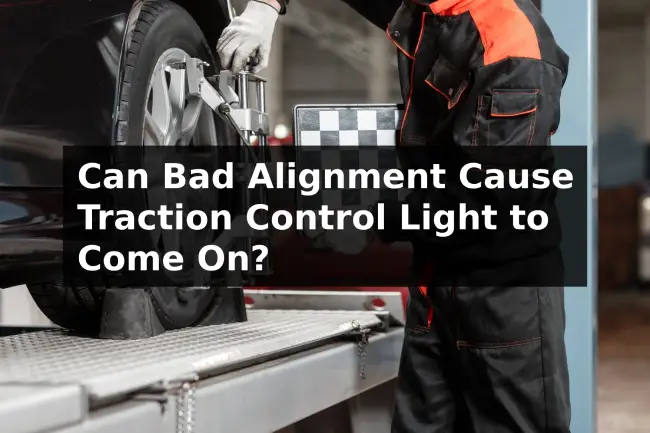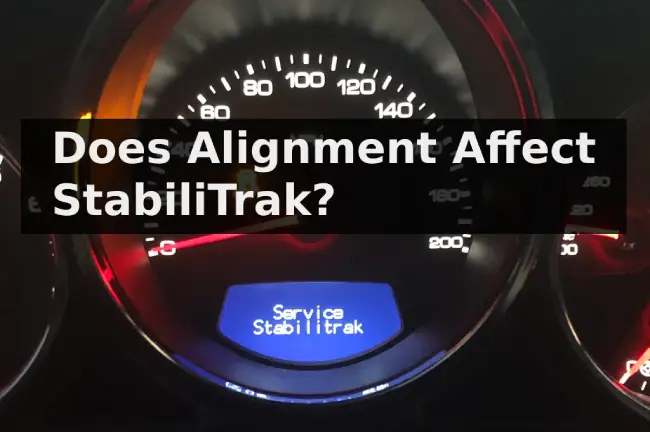The traction control light illuminating the dashboard can be a frustrating experience for both experienced and new drivers. It can come on due to many factors, such as a broken wheel sensor, faulty steering angle sensor, and weather conditions. Etc. But can a bad wheel alignment cause a traction light to come on?
Incorrect wheel alignment disrupts the general stability of the car and its drivability. If the traction control light comes and stays on for a while, there could be a problem with wheel alignment.
However, many other reasons can also cause the traction control light to come on. Read on to find out more about what causes it to illuminate your dashboard and how bad wheel alignment contributes to it.
Can A Bad Alignment Affect Traction Control?
Yes, a bad alignment can trigger the fault code that makes the control module turn on the traction control light. A proper wheel alignment is necessary to keep the wheels running straight and flawless. But with poor alignment, your tires wear out faster.

Bad wheel alignment is one of the most common causes of traction control light on the dashboard. However, you should not rule out other possibilities, which include the following:
Faulty Steering Angle Sensor
A steering angle sensor is located in the steering column. As the name suggests, it measures the steering wheel angle, relative position, and rotation speed. The obtained data is passed to the control module. Any defect in this sensor leads to incorrect data that can adversely affect the computation. Hence, the traction control light comes on.
Faulty Wheel Speed Sensor
Wheel speed sensors measure the wheel speed and relay the information to the control unit. The traction control system also uses the same data from the wheel speed sensor to intelligently apply brakes and avoid wheel locking. Any discrepancies in the data received from any wheel speed sensor cause the traction control light to come on.
Faulty Steering Rack
The steering rack is connected to your steering wheel and forms an integral part of the power steering system. It receives the pressurized hydraulic fluid needed to make steering effortless. A faulty steering wheel rack makes it harder to steer the vehicle, especially on rough terrains. That can possibly trigger the traction control light.
Related content: Should You Replace Both Inner and Outer Tie Rods at the Same Time?
Low Tire Pressure
Wheel speed sensors detect the wheel speed and forward that information to the ABS and traction control unit. Its operation can be affected by tire pressure. Under low tire pressure conditions, the wheel loses shape, interfering with the wheel speed sensor. As a result, your traction control warning light might trigger.
Most new cars come with a TPMS that will warn you whenever there is a drop in tire pressure.
Road Conditions and Weather
If you are driving on a muddy or snowy road, you will notice that the traction control light flashes or is constantly on. That is usually nothing to worry about, as it only indicates that the traction control system is adapting to the road conditions and doing what it is supposed to do. But if it stays on, there is a fault that you should fix.
Manual Override Function
Most vehicles have a switch on the dashboard to allow drivers to turn ON or OFF the traction control system. The light comes on when it is manually turned off using that switch. But in most cases, the dashboard symbol includes the word OFF in this situation. It is possible that you might have turned it OFF before without noticing.
It is not unheard of to have various car settings changed, or safety systems turned OFF when having the car cleaned.
Systematic Failure
Most systems in automobiles are interconnected. The traction light can also come on if there is an issue with the ECU, programming, limp mode, or any other system failure. This is the least common cause, but when it happens, it can cost quite a while to diagnose and fix.
Does Alignment Affect StabiliTrak?
Indeed, StabiliTrak can be affected by poor alignment, causing the warning light to come on. However, similar to traction control, a StabiliTrak warning light can be caused by other issues with the vehicle, such as faulty speed sensors, a bad steering angle sensor, or muddy/snowy road conditions.

StabiliTrak is an electronic stability control system similar to the traction control system but has a different function. This system ensures you drive in a straight line and prevent swaying off the road, even if you hit an obstacle or a speed bump. It uses data from the steering and wheel sensors to get into the action.
As mentioned, a bad wheel alignment affects the operation of the wheel speed sensors. That will trigger the StabiliTrak warning light on the dashboard. Other common symptoms of a malfunctioning StabiliTrak system include an engine power loss and activation of limp mode.
Apart from bad wheel alignment, the operation of StabiliTrak can also be affected by the following:
- A faulty throttle position sensor
- Defective steering wheel position sensor
- ABS sensor problem
- Defective fuel pump
- Active Fuel Management (AFM) issue
- Faulty tire pressure monitor sensors
- Faulty brake switch
- Body control module issues
StabiliTrak is one of those systems that are dependent on multiple other systems and sensors to run. Whenever one of those systems and sensors becomes faulty, the system will stop working. Diagnosing and fixing a StabiliTrak fault can become quite costly.
What Are the Symptoms of a Car That Is Out of Alignment?
As a driver, you should keep your wheels well aligned at all times. Its benefits include a longer tire lifespan, better fuel efficiency, and good overall performance. It can also protect your suspension system and components from any premature wear.
However, it’s challenging to keep proper wheel alignment throughout the vehicle’s service life. Regardless, you should avoid driving straight into potholes, hitting curbs, or collisions with objects. These and some other factors will result in misaligned wheels.
So, how do you know if you need wheel realignment? The following are the most common signs of bad alignment:
- Your vehicle pulls to one side
- Car shakes or vibrates on the road
- Bumpy ride
- Vibrating steering wheel
- Uneven or excessive tire wear
- Uneven steering wheel
- Squealing tires during acceleration
Although not many drivers do this, it is recommended to check your wheel alignment on a regular basis. Performing a wheel alignment check once a year can save you money on fuel and prolong the lifespan of your tires.
Is It Safe to Drive with The Traction Control Light On?
Yes, but only for a few miles and under certain road conditions and weather. As traction control is a safety system, driving a vehicle with a faulty or inactive system can be dangerous. The traction control light warns you of a problem with the traction control system, which keeps you safe on slippery roads.
A traction control system monitors all the wheels and identifies wheels that lose their grip on the road. It then responds by applying brakes or cutting engine power to that individual wheel to avoid slipping or skidding. It ensures all wheels keep traction and gives you steering control.
You should address the traction control light at the first opportunity to stay safe on the road and ensure the safety of other road users. You never know when the weather will change for the worse to endanger yourself.
In Summary
To function properly, cars rely on multiple systems and sensors that work together. Whenever one of those systems becomes faulty, there will be a chain reaction causing all sorts of warnings to show on your dashboard.
While a bad wheel alignment might be the cause of your traction control warning, there can be other factors involved as well. But when it comes to diagnosing car problems, it is always recommended to start by checking the easiest places where the fault could be, in our case: the wheel alignment.
Proper maintenance will always prevent most of those faults from developing. So, remember! Look after your car, and in turn, it will look after you and your wallet!
My name is Jeffrey Williams and I have been a car mechanic for over 35 years. I am currently working NYC Auto Repair Shop, in New York City and recently developed a strong passion about blogging. I decided to put together this blog where I will try and answer the most commonly asked questions I get on a daily basis from my customers.








